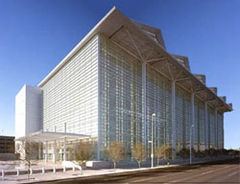Status Complete Country United States Cost 123 million USD Floor count 6 | Type Courthouse Inaugurated October 2000 | |
 | ||
Address 401 West Washington Street Current tenants • United States Court of Appeals for the Ninth Circuit • United States District Court for the District of Arizona Floor area 550,000 square feet (51,000 m) Similar New Harmony's Atheneum, Frederick J Smith House, Douglas House, Phoenix Financial Center, Jubilee Church | ||
The Sandra Day O'Connor United States Courthouse is a courthouse at 401 West Washington Street in Phoenix, Arizona. Pursuant to Pub.L. 106–166, enacted by the United States Congress, it is named after Sandra Day O'Connor, who served as an Associate Justice of the Supreme Court of the United States from September 21, 1981 to January 31, 2006.
Contents
- Map of Sandra Day OConnor United States Courthouse W Washington St Phoenix AZ 85003 USA
- Description
- Climate control problems
- References
Map of Sandra Day O'Connor United States Courthouse, W Washington St, Phoenix, AZ 85003, USA
Description
The building is home to the United States District Court for the District of Arizona, and also hosts Circuit Judges William C. Canby, Jr.; Michael Daly Hawkins; Mary H. Murguia; Mary M. Schroeder; and Barry G. Silverman of the United States Court of Appeals for the Ninth Circuit.
Built at a cost of $123 million and dedicated in October 2000, the building was championed by Senior United States District Judge Robert C. Broomfield. It was designed by architect Richard Meier, with local executive architects of Langdon Wilson Architecture in Phoenix. The building is in Meier's signature monochrome style. Standing six stories tall, it encompasses more than 550,000 square feet (51,000 m2). The building's public atrium features a six-story glass curtain wall on the north face, and contains a drum-shaped special-proceedings courtroom with a glass-lens ceiling, the work of James Carpenter, an American light artist and designer. There is no public parking.
Climate-control problems
Although part of the General Services Administration's initiative to bring design excellence to public buildings, the building has been plagued with climate-control problems with its evaporative-cooling system. Temperatures in the atrium have been known to reach 100 °F (38 °C) in the summer, and the ceiling was open to dust storms, but now motorized louvers prevent infiltration during storms.
